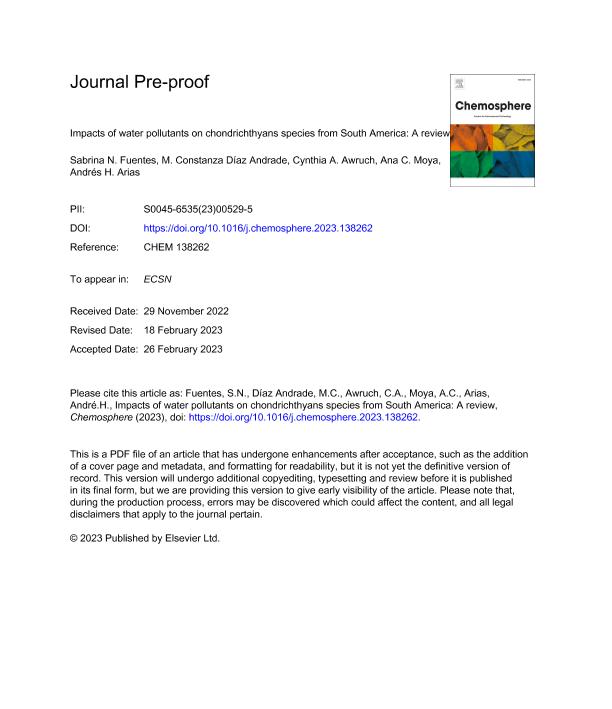Mostrar el registro sencillo del ítem
dc.contributor.author
Fuentes, Sabrina Natalia

dc.contributor.author
Díaz Andrade, María Constanza

dc.contributor.author
Awruch, Cynthia Andrea

dc.contributor.author
Moya, Ana Carolina

dc.contributor.author
Arias, Andres Hugo

dc.date.available
2024-03-04T15:30:37Z
dc.date.issued
2023-03-02
dc.identifier.citation
Fuentes, Sabrina Natalia; Díaz Andrade, María Constanza; Awruch, Cynthia Andrea; Moya, Ana Carolina; Arias, Andres Hugo; Impacts of water pollutants on chondrichthyans species from South America: A review; Elsevier Ltd; Chemosphere; 324; 2-3-2023; 1-9
dc.identifier.issn
0045-6535
dc.identifier.uri
http://hdl.handle.net/11336/229244
dc.description.abstract
This is the first research which extensively compiles all the available scientific literature on the presence of trace metals (TMs), persistent organic pollutants (POPs), and plastic debris in Chondrichthyan species inhabiting South America (including the Atlantic and Pacific Oceans), providing an insight into Chondrichthyans as bioindicators of pollutants as well as the impacts of pollutant exposure on the organisms. Seventy-three studies were published in South America between 1986 and 2022. While 68.5% focused on TMs, 17.8% on POPs, and 9.6% on plastic debris. Brazil and Argentina were at the top in terms of the number of publications; however, there is an absence of information regarding pollutants for Chondrichthyans in Venezuela, Guyana, and French Guiana. Of the 65 Chondrichthyan species reported, 98.5% belong to the Elasmobranch group, and 1.5% from the Holocephalans. Most studies focused on Chondrichthyans of economic importance, and the most analyzed organs were the muscle and liver. There is a lack of studies on Chondrichthyan species with low economic value and critical conservation status. Due to their ecological relevance, distribution, accessibility, high trophic position, capacity to accumulate high levels of pollutants, and the number of studies published, Prionace glauca and Mustelus schmitii seem to be adequate to serve as bioindicators. For TMs, POPs, and plastic debris there is a lack of studies focusing on the pollutant levels as well as their effect on Chondrichthyans. Future research reporting TMs, POPs, and plastic debris occurrence in Chondrichthyan species are required in order to increase the scarce databases about pollutants in this group, with a clear need for further research on the responses of chondrichthyans to pollutants, as well as making inferences about the potential risks to the ecosystems and human health.
dc.format
application/pdf
dc.language.iso
eng
dc.publisher
Elsevier Ltd

dc.rights
info:eu-repo/semantics/openAccess
dc.rights.uri
https://creativecommons.org/licenses/by-nc-sa/2.5/ar/
dc.subject
ELASMOBRANCHII
dc.subject
HOLOCEPHALI
dc.subject
PERSISTENT ORGANIC POLLUTANTS
dc.subject
TRACE METALS
dc.subject
PLASTIC DEBRIS
dc.subject.classification
Oceanografía, Hidrología, Recursos Hídricos

dc.subject.classification
Ciencias de la Tierra y relacionadas con el Medio Ambiente

dc.subject.classification
CIENCIAS NATURALES Y EXACTAS

dc.title
Impacts of water pollutants on chondrichthyans species from South America: A review
dc.type
info:eu-repo/semantics/article
dc.type
info:ar-repo/semantics/artículo
dc.type
info:eu-repo/semantics/publishedVersion
dc.date.updated
2023-11-02T14:05:15Z
dc.identifier.eissn
1879-1298
dc.journal.volume
324
dc.journal.pagination
1-9
dc.journal.pais
Países Bajos

dc.journal.ciudad
Amsterdam
dc.description.fil
Fil: Fuentes, Sabrina Natalia. Consejo Nacional de Investigaciones Científicas y Técnicas. Centro Científico Tecnológico Conicet - Bahía Blanca. Instituto de Ciencias Biológicas y Biomédicas del Sur. Universidad Nacional del Sur. Departamento de Biología, Bioquímica y Farmacia. Instituto de Ciencias Biológicas y Biomédicas del Sur; Argentina
dc.description.fil
Fil: Díaz Andrade, María Constanza. Consejo Nacional de Investigaciones Científicas y Técnicas. Centro Científico Tecnológico Conicet - Bahía Blanca. Instituto de Ciencias Biológicas y Biomédicas del Sur. Universidad Nacional del Sur. Departamento de Biología, Bioquímica y Farmacia. Instituto de Ciencias Biológicas y Biomédicas del Sur; Argentina
dc.description.fil
Fil: Awruch, Cynthia Andrea. Consejo Nacional de Investigaciones Científicas y Técnicas. Centro Científico Tecnológico Conicet - Centro Nacional Patagónico. Centro para el Estudio de Sistemas Marinos; Argentina
dc.description.fil
Fil: Moya, Ana Carolina. Consejo Nacional de Investigaciones Científicas y Técnicas. Centro Científico Tecnológico Conicet - Bahía Blanca. Instituto de Ciencias Biológicas y Biomédicas del Sur. Universidad Nacional del Sur. Departamento de Biología, Bioquímica y Farmacia. Instituto de Ciencias Biológicas y Biomédicas del Sur; Argentina
dc.description.fil
Fil: Arias, Andres Hugo. Consejo Nacional de Investigaciones Científicas y Técnicas. Centro Científico Tecnológico Conicet - Bahía Blanca. Instituto Argentino de Oceanografía. Universidad Nacional del Sur. Instituto Argentino de Oceanografía; Argentina
dc.journal.title
Chemosphere

dc.relation.alternativeid
info:eu-repo/semantics/altIdentifier/url/https://linkinghub.elsevier.com/retrieve/pii/S0045653523005295
dc.relation.alternativeid
info:eu-repo/semantics/altIdentifier/doi/http://dx.doi.org/10.1016/j.chemosphere.2023.138262
Archivos asociados
